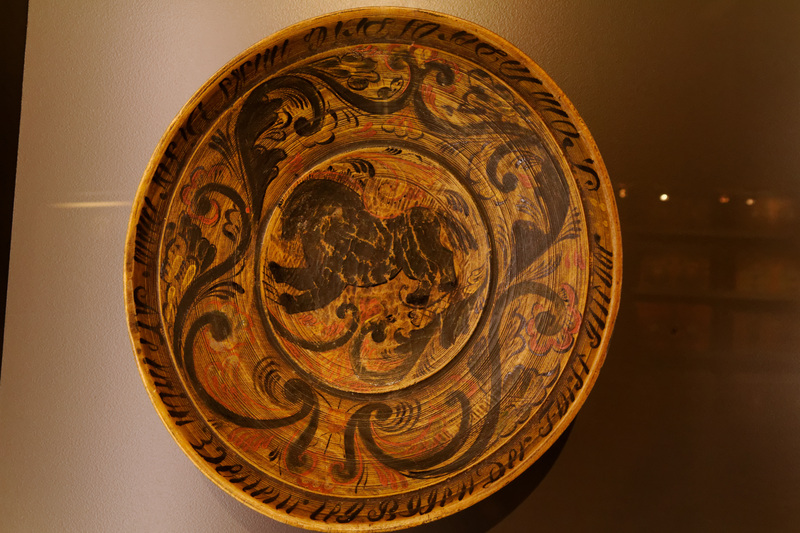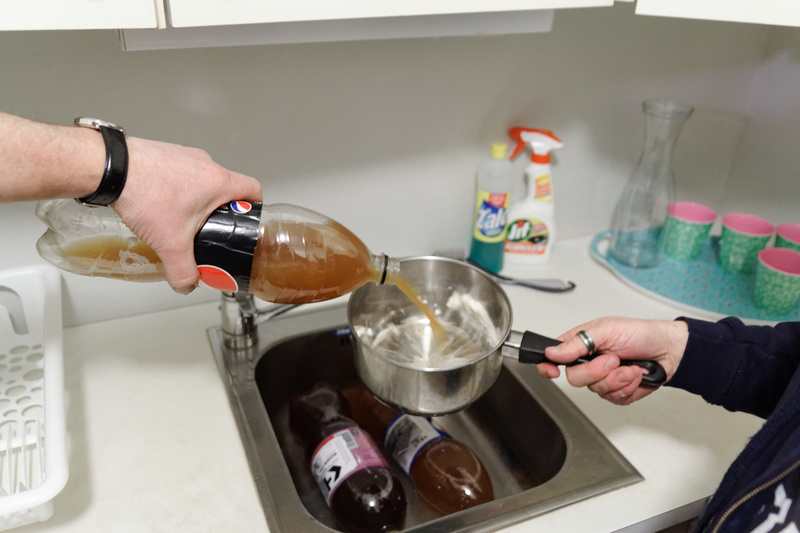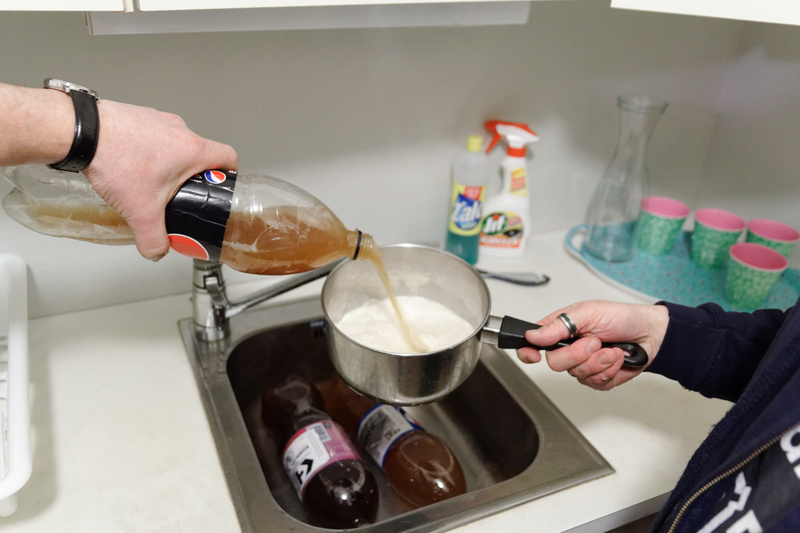Roaring the beer

Beer bowl from upper Telemark |
The first time I heard about it was in Telemark (southern Norway), where Halvor Nordal said that one of his neighbours used to sometimes heat the beer very briefly in a saucepan before serving it. His neighbour thought it made the beer taste fresher. I mentally filed this under "Weird, unexplained things" and just left it there. For a few years.
Then, the year after, I visited Rasmus Kjøs Otterdal in Hornindal, 300km to the northwest, and he told me about the same thing, this time in a little more detail. People served the beer this way to bring out more aroma and carbonation in the beer. That last part may sound odd, but farmhouse ale generally has very low carbonation, rather like British cask ale. I've several times heard the brewers complain about the carbonation being too low.
Rasmus explained what people did was to take an empty saucepan and heat it quite well on the stove. Then you took it off the stove and poured the beer straight into the saucepan. The beer would give off a fierce fizzing sound and a thick head would instantly form on it. It tastes great if you drink it right away, but doesn't last long, he said. People would usually do this with old beer that was a bit stale to make it taste more fresh.

Otterdalen, where Rasmus lives |
They called this "å belje ølet". According to Rasmus "belje" was a general term for heating things up, but Ivar Aasen's old dialect dictionary records only one meaning for the word: "to roar/scream," and that's how I know the word, too. They added that some people called it "å brøle ølet" (to roar the beer), obviously referring to the powerful hissing sound when the beer hits the hot saucepan.
I'd assumed this was something modern, but if people in both Telemark and Hornindal did it, presumably it was an older custom? And it turns out it is. Hans Gjeitvik published a book titled (my translation) "Farmer's lives in Sunnmøre at the start of the previous century" in 1926. So he's writing about the early 19th century, and he says of the Christmas dinner: "A pot was set over the embers [in the fireplace], and heated so much it would hiss if water were poured into it. Then the head of the household came with a big bowl of beer and poured this in the pot to heat it." The heated beer was then served together with the Christmas dinner.
For Christmas people then as now typically served the best they could get their hands on. And indeed he writes the Christmas dinner was "the finest of the year" (just before the quote above), so clearly this was not something that was done to freshen up stale beer. It must have been seen (at least then and there) as the best way to serve the beer.

The view from the ferry to Norddal, in February |
In 2017 we had the annual meeting of the farmhouse ale festival board, in Norddal, not far from Hornindal. Late in the evening we were in a hotel room, drinking farmhouse ale that some of the board members brought, when the subject came up again. Ståle Raftevold (nephew of Rasmus, brother of Terje) knew about "roaring the beer", and since we had a kitchen with a stove and saucepans, we decided to give it a go, with Ståle showing how to do it.

Beginning to pour. Left, Ståle Raftevold. Right, William Holden. |
An empty saucepan was heated on the stove, and the beer poured in. The fierce hissing started immediately, and the promised thick, rich white head formed. When the beer was poured over in glasses that thick, lovely head stayed there. Farmhouse ale is generally soft and delicate in the mouth, but this beer was really smooth, soft, and fluffy, and weirdly warm. The mouthfeel was not completely unlike Irish coffee. And what was promised turned out to be true: it really did bring out the fruity aroma as well. We all really, really liked this way of serving the beer, much to our surprise.

Most of the beer is in |
At the farmhouse ale festival that year, Baatbryggeriet, a small craft brewery from nearby Vestnes, brought not just their farmhouse ale interpretations, but also a tiny tabletop stove and a saucepan. So people dropping by their stand could choose to have the beer served the normal way, or "roared". I had try it roared, of course, and recorded this video.
I apologize for the sound quality, video quality, and editing, but this was close to midnight, when the festival had transitioned into full-on party mode. Since, as far as I know, it's the only video of beer being roared ever made, I included it anyway.
Roaring the beer works really well with farmhouse ale. I've tried it once with a brown ale, and felt it didn't work at all. It actually brought out what tasted like brewing flaws in the brown ale, but I felt they hadn't been there when it was served the normal way. So although I've only tried this three times I think you need to pick the type of beer to try it on quite carefully, and real farmhouse ale is probably the best bet.
On another note, when I talk about Norway having its own beer culture, this is the kind of thing I have in mind, together with oppskåke, the beer styles, kveik, and quite a few other things.
Sources
Bondeliv på Sunnmøre i begynnelsen av det forrige århundrede, Hans Gjeitvik, Hjelle, 1926. Page 97.
Norsk Ordbog, Ivar Aasen, Christiania, 1873.
Similar posts
Hornindal: interviews and collecting kveik
Terje learned to brew from his uncle when he was 16, while helping him on the farm during the summer
Read | 2016-01-03 14:15
East of the mountains: gong
I got the tip-off from Jørund Geving, a farmhouse brewer in Stjørdal
Read | 2020-04-04 13:11
Comments
Øyvind Langgård - 2018-04-22 13:09:46
Spennende lesning!
Dette kan jo høres litt ut som den tyske vinter-tradisjonen med «bier stacheln». Utførelsen er ikke lik, men resultatet og prinsippet er det samme. Kanskje de har samme opphav?
https://craftbeer-revolution.de/specials/bierstacheln-ein-winterliches-geschmackserlebnis
Lars Marius Garshol - 2018-04-22 13:12:55
Yes, that does sound very similar, even if the method is a little different. It could well be that they share a common origin. Or it could have developed separately. I don't really know. Thank you, though!
Richard - 2018-04-22 13:42:53
We do something similar at the lab to do a quick sensory test for diacetyl - the forced diacetyl test which involves heating finished but uncarbonated beer to convert the diacetyl precursor to diacetyl and thus assess the 'diacetyl potential' of a fermenting beer. Unfortunately heating young beer does accentuate diacetyl as well as fusels (among other fermentation flaws). However older Norwegian farmhouse ale seems to not have as much diacetyl as the fresh stuff, and never really has fusel notes. So maybe roaring slightly old beer actually tastes better anyway?
Thomas - 2018-04-22 17:53:00
Artig lesning! Her på Kongsberg (ikke langt fra Telemark) er «å bælje» det samme som å styrte ølet. Dvs drikke veldig fort.
Till - 2018-04-22 19:30:27
This reminds me of the "Bierstacheln" technique. I think it's most popular in Austria. You pour a dark, malty beer into an earthen drinking vessel. You only fill it to about half. Then you heat a steel rod in a fire until it glows red hot. This is the traditional way, feel free to experiment, just don't use anything that doesn't like heat or doesn't belong in food. You dip the hot rod into your beer. It will foam up very rapidly and there will be a loud hiss. Pull the rod out when it goes quiet and calm. The beer will have lost some carbonation and will have warmed up, but the remaining sugars in the beer will have caramelized slightly, resulting in a very unique flavour.
Give this a try guys, farmhouse beer is not required, but I believe a strong or at least a sweet beer will yield best results :)
Dave - 2018-04-23 17:58:28
Very interesting. I'm going to have to try this some time!
Lars Marius Garshol - 2018-04-24 19:09:50
I got this page about English and German ale warming from Alec Latham: http://www.oldandinteresting.com/ale-warmers.aspx
Allan - 2019-03-30 21:40:46
Fascinating! I distinctly remember the old men in the beer halls in Salzburg setting their full earthenware mugs into a little warm bath, the Bierwarmer. Seemed super weird to me at the time but have since made ale flip, yard of flannel, het pint, and other warm beer "cocktails" from Britain. Thanks for sharing!
Dennis - 2020-10-25 21:39:29
Not exactly related, but I was wondering at what temperature Norwegian farmhouse ales (and Sahti) are typically drunk? Are they usually drunk at room temperature?
Lars Marius Garshol - 2020-10-26 06:52:37
@Dennis: Usually a little colder than room temperature. Something like cellar temperature: 12-14C.
Casey Wolf - 2020-11-24 02:42:13
My grandmother is of portuguese descent, raised in the Fall River Massachusetts area. When she gets a beer that reminds her of the house brewed ales her father and grandfather would make she says they often took a hot iron poker from the fire and plunged it into the cup of ale to serve it with a head.